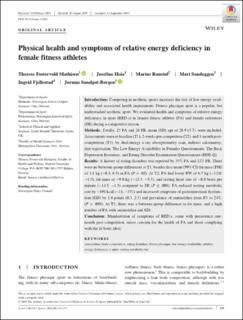Physical health and symptoms of relative energy deficiency in female fitness athletes
| dc.contributor.author | Mathisen, Therese Fostervold | |
| dc.contributor.author | Heia, Josefine | |
| dc.contributor.author | Raustøl, Marius Løvic | |
| dc.contributor.author | Sandeggen, Mari | |
| dc.contributor.author | Fjellestad, Ingrid | |
| dc.contributor.author | Sundgot-Borgen, Jorunn | |
| dc.date.accessioned | 2020-05-13T08:58:06Z | |
| dc.date.available | 2020-05-13T08:58:06Z | |
| dc.date.created | 2020-01-31T08:26:47Z | |
| dc.date.issued | 2019 | |
| dc.identifier.citation | Scandinavian Journal of Medicine & Science in Sports. 2019, 30(1), 135-147. | en_US |
| dc.identifier.issn | 0905-7188 | |
| dc.identifier.uri | https://hdl.handle.net/11250/2654183 | |
| dc.description | This is an open access article under the terms of the Creative Commons Attribution License (http://creativecommons.org/licenses/by/4.0/), which permits use, distribution and reproduction in any medium, provided the original work is properly cited. | en_US |
| dc.description.abstract | Introduction: Competing in aesthetic sports increases the risk of low energy availability and associated health impairments. Fitness physique sport is a popular, but understudied aesthetic sport. We evaluated health and symptoms of relative energy deficiency in sport (RED‐s) in female fitness athletes (FA) and female references (FR) during a competitive season. Methods: Totally, 25 FA and 26 FR, mean (SD) age of 28.9 (5.7), were included. Assessments were at baseline (T1), 2‐weeks pre‐competition (T2), and 1‐month post‐competition (T3), by dual‐energy x‐ray absorptiometry scan, indirect calorimetry, diet registration, The Low Energy Availability in Females Questionnaire, The Beck Depression Inventory, and Eating Disorder Examination Questionnaire (EDE‐Q). Results: A history of eating disorders was reported by 35% FA and 12% FR. There were no between‐group differences at T1, besides less mean (99% CI) fat mass (FM) of 3.1 kg (−0.4, 6.5) in FA (P = .02). At T2, FA had lower BW of 6.7 kg (−12.0, −1.3), fat mass of −9.0 kg (−12.5, −5.5), and resting heart rate of −8.0 beats per minute (−14.5, −1.5) compared to FR (P ≤ .006). FA reduced resting metabolic rate by −191 kcal (−11, −371) and increased symptoms of gastrointestinal dysfunction (GD) by 1.4 points (0.3, 2.5) and prevalence of amenorrhea from 8% to 24%, (P < .003). At T3, there was a between‐group difference in fat mass, and a high number of FA with amenorrhea and GD. Conclusion: Manifestation of symptoms of RED‐s, some with persistence one‐month post‐competition, raises concern for the health of FA and those complying with the fit body ideal. | en_US |
| dc.language.iso | eng | en_US |
| dc.subject | amenorrhea | en_US |
| dc.subject | body composition | en_US |
| dc.subject | eating disorders | en_US |
| dc.subject | fitness physique | en_US |
| dc.subject | low energy availability | en_US |
| dc.subject | relative energy deficiency in sport | en_US |
| dc.subject | resting metabolic rate | en_US |
| dc.title | Physical health and symptoms of relative energy deficiency in female fitness athletes | en_US |
| dc.type | Peer reviewed | en_US |
| dc.type | Journal article | en_US |
| dc.description.version | publishedVersion | en_US |
| dc.rights.holder | © 2019 The Authors. | en_US |
| dc.source.pagenumber | 135-147 | en_US |
| dc.source.volume | 30 | en_US |
| dc.source.journal | Scandinavian Journal of Medicine & Science in Sports | en_US |
| dc.source.issue | 1 | en_US |
| dc.identifier.doi | 10.1111/sms.13568 | |
| dc.identifier.cristin | 1787429 | |
| dc.description.localcode | Seksjon for idrettsmedisinske fag / Department of Sports Medicine | en_US |
| cristin.ispublished | true | |
| cristin.fulltext | original | |
| cristin.qualitycode | 2 |
Tilhørende fil(er)
Denne innførselen finnes i følgende samling(er)
-
Artikler / Articles [2096]
-
Publikasjoner fra Cristin [1084]
